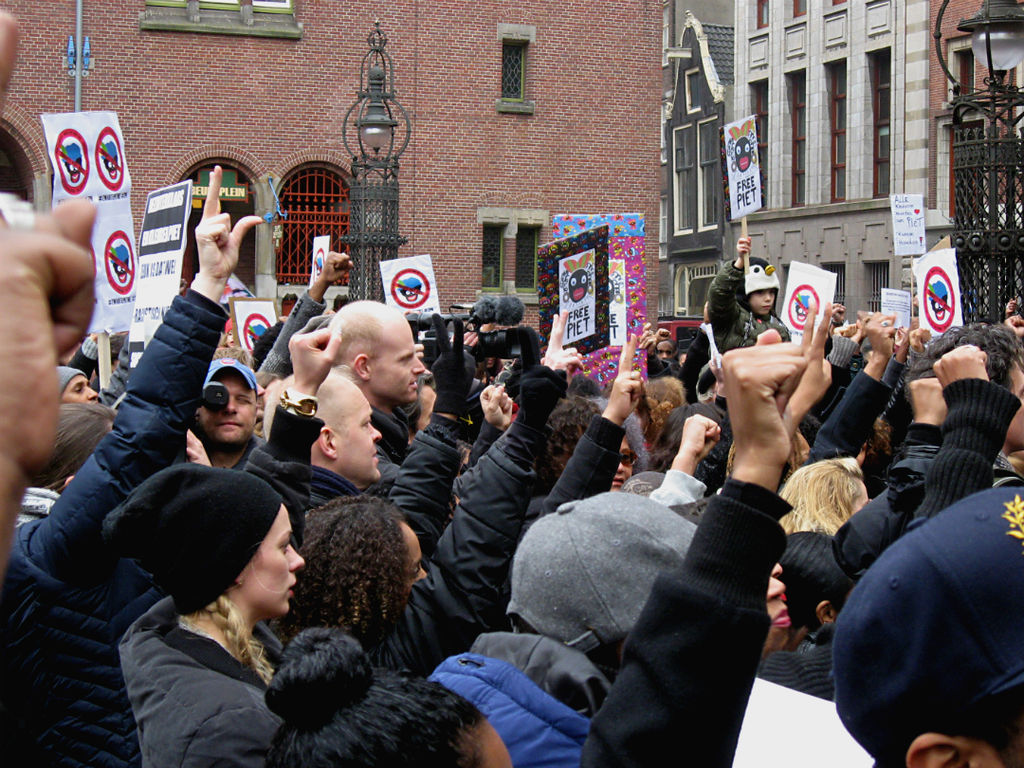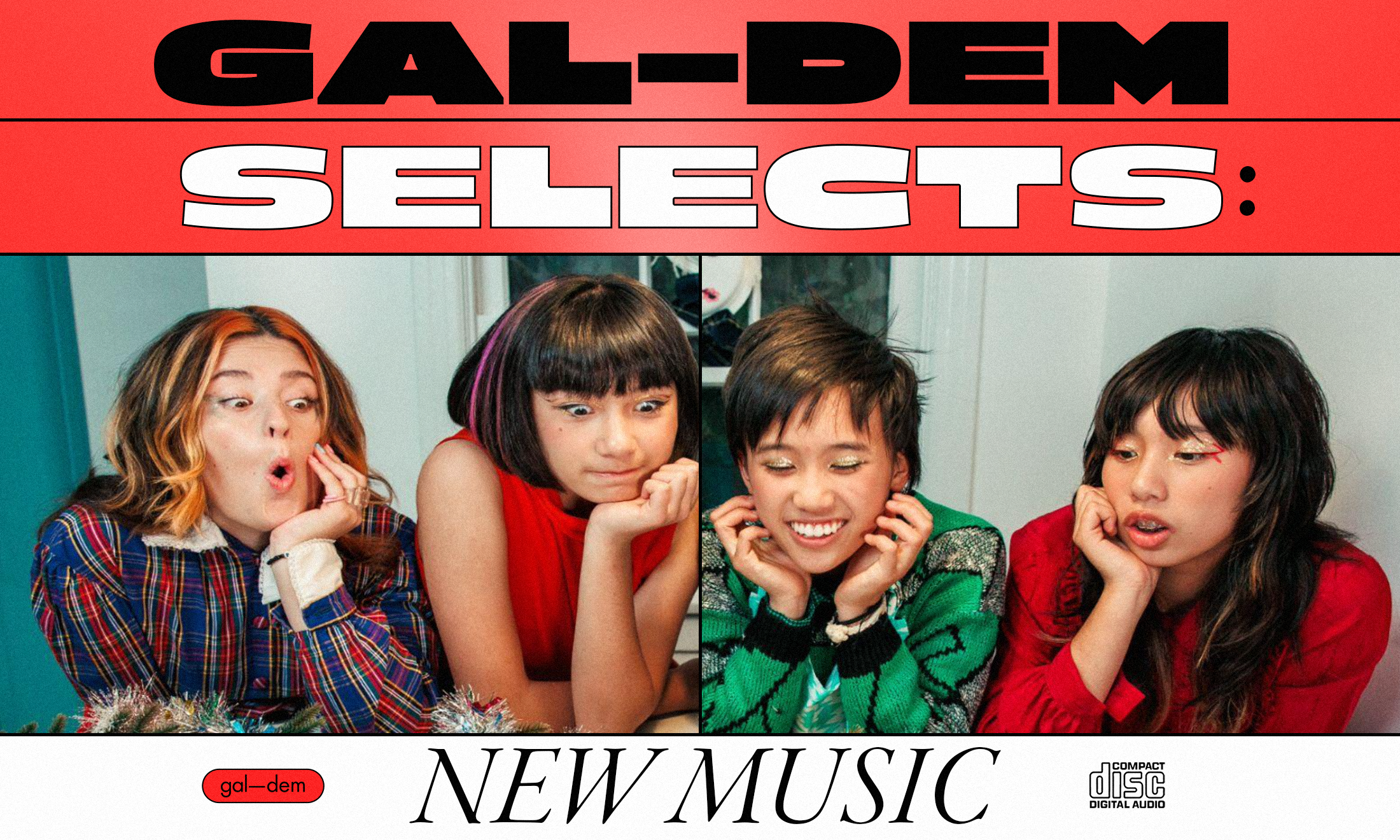
Image by Constablequackers/Wikimedia Commons
We have just survived another Sinterklaas season in the Netherlands.The wintery gift-giving festival promotes a white-washed mythology based around the figure of Saint Nicholas, who was Bishop of Myra in what is now present-day Turkey during the 4th century. While there are various traditions across Europe to honour the memory of this particular saint on the anniversary of his death (December 6), according to the Dutch, he arrives on a steamboat from Spain each year accompanied by his white horse, named Amerigo, and an entourage of enslaved black folks collectively known as Zwarte Pieten (Black Petes).
In the earliest iterations of the Dutch Sinterklaas festival, Piet was closer to the demonic Krampus character associated with Saint Nicholas in other traditions. However, in the mid-1800s, a Dutch teacher reintroduced the festival as the ultimate white patriarchal supremacist fantasy in his book Sinterklaas en zijn knecht (Sinterklaas and his Slave): Saint Nicholas would now be accompanied by Piet, a young servant of African descent.
By the turn of the century, Piet looked increasingly like a golliwog, with wide eyes, a grotesquely enlarged mouth and lips, a wild afro and jet black skin, as well as golden earrings, a common feature in colonial era artworks to demonstrate the wealth of the owner of an enslaved person. In the flesh, he was depicted by a white person using blackface make-up and buffoonish behaviour to portray the Saint’s servant. It was quite common until recent years for white Dutch folks playing Zwarte Piet to use a mock Surinamese accent as well, linking the character inextricably to the Dutch colonial slave project. Over the years, as Sinterklaas parades became more popular across the country, the Saint would be accompanied by more and more Pieten.
“By 2010, it was perfectly normalised for Saint Nicholas to dock his (slave) ship full of hundreds of men and women in blackface in Amsterdam”
By 2010, it was perfectly normalised and expected for the white Saint Nicholas to dock his (slave) ship – full of hundreds of men and women in blackface, playing the role of enslaved Africans – in Amsterdam, then ride through the crowds of adoring, predominantly white parents and their children on his horse, named for the Italian colonist who charted the route to the lands we now call the Americas. There has always been pressure from community campaigners, academics and artists to change Zwarte Piet due to the implied racism of the figure, dating at least as far back as the 1940s. However normalised the various characterisations were at the turn of the decade, mounting social pressure against the use of blackface started to boil over.
In the last ten years, as a new critical discourse around Dutch identity, culture and belonging has begun to flourish, the inclusivity of certain traditions – such as Sinterklaas – has been continuously questioned. Art projects such as Read the Masks: Traditions is Not a Given by Petra Bauer and Annette Krauss, and the prominent and influential Zwarte Piet is Racisme by Quinsy Gario and Jerry Afriyie directly challenged the unquestioned Dutch affection for a character linked to anti-black treatment. Particularly since the arrests of Gario and Afriyie at a Dordrecht Sinterklaas parade in 2011, an enormous shift has occurred within public dialogue on whether or not blackface should be a part of 21st century Dutch culture, as well as who has the right to question, shape and participate in Dutch traditions.
Since 2013, the European Race and Imagery Foundation (ERIF) have followed the debate and supported and amplified anti-blackface campaigns in the Netherlands closely. In 2014 ERIF held a conference on this topic with thinkers from across Europe, and in 2015 launched their ongoing research project to measure the use of blackface in marketing and packaging in supermarkets and online stores, year-on-year during the Sinterklaas season.
“Cities such as Rotterdam and The Hague have made pledges in recent years to phase out the use of blackface”
The latest data gathered by ERIF (due to be published in February 2019) shows that over 50 percent of Sinterklaas products actually do not refer to [Zwarte] Piet at all. Where Piet is included in advertisements, brands are increasingly moving towards the use of either multi-coloured face paint or soot marks to replace blackface and enlarged red lips. In line with the pledges large cities such as Rotterdam and The Hague have made in recent years to phase out the use of blackface, be it in schools or the parades, wigs, earrings and fake Surinamese accents are also on the decline. Having said all of this, the most offensive and anti-black depictions of Piet continue to make up 19 percent of the products and ads ERIF analysed.
It is crucial to place Zwarte Piet in the context of rising xenophobia and racism towards black people in the Netherlands. For instance, journalist Seada Nourhussen recently announced she would no longer contribute a regular column to Dutch newspaper Trouw due to the racist hate mail she has received over the years. In addition, leader of political party BIJ1, Sylvanna Simons, has faced vicious racist threats for calling out discrimination faced by Dutch people of colour. In ERIF’s recent report, community organiser and writer Simone Zeefuik discussed the need for uplifting and supportive gatherings of black Dutch women, as well as a broader sense of black Dutch collectivity in the fight against racism in the Netherlands.
ERIF also spoke with artist and exhibition maker Richard Kofi, whose work focuses on the creolisation and decolonisation of museums as well as notions of Africaness and Dutchness. Meanwhile, Marny Garcia spoke to ERIF about her work as part of the Afro Students Association (ASA) at Leiden University’s campus in The Hague, to make the institution more inclusive for students of colour. The anti-black and Islamophobic racism towards students and teachers was recently reported in Leiden University’s newspaper and it is striking that the author of the article did not feel comfortable to publish their name. Additionally, campaign group Kick Out Zwarte Piet (KOZP) were forced to cancel a gathering planned with ASA in The Hague, due to threats to the safety of protestors.
“Black protestors have been violently arrested for peacefully demonstrating at Sinterklaas parades”
A recent poll concluded that more people than ever are willing for the Piet character to change, however ERIF’s research indicates a steady increase in the levels of opposition to changing the Piet figure to a less racist characteristic, particularly because of who the campaigners are. Xavier Donker of OCAN, a foundation which defends the interests and rights of Dutch Caribbean citizens in the Netherlands, who was interviewed this year by ERIF, attributes this to a widespread sense of colonial amnesia and “disregard for others’ feelings”. There are institutional implications at play as well. While black protestors (and their allies) have been violently arrested for peacefully demonstrating at Sinterklaas parades, more aggressive counter-protests have been allowed to take place. In 2017, pro-Piet protestors blocked the highway to Dokkum so that anti-racism activists could not protest at the parade, even though they had official permission to demonstrate. No immediate arrests were made for those responsible for blocking the road; they have now received community service sentences.
This year, in Eindhoven, children in full Zwarte Piet blackface garb led crowds in racist chants and put up their middle fingers to protestors, while racist adults threw eggs and beer cans. Artist-activist and educator Gloria Holwerda described similar scenes in in the city of Leeuwarden for ERIF’s report. Additionally, in Den Helder, protestors once again could not proceed to their pre-agreed location due to racist threats; instead of the police and the mayor subduing the counter-protestors, they found ways to prevent KOZP from attending their agreed demonstration. Prime Minister Rutte has been less than impartial on this matter, stating in 2013 “Black Piet is black and I can’t change that”, then proclaiming in 2017 that newcomers should assimilate into Dutch culture unquestionably “or leave”. This year he changed his tune ever so slightly, to condemn the counter-protestors for obstructing their fellow citizens’ legitimate right to freedom of expression, but this may be too little too late.
It seems to be the case that simply calling out racism in order to make the Netherlands more inclusive inspires the worst outbursts of white entitlement and fragility. Even though this topic is not the only site of anti-blackness, as ERIF’s annual report shows the Sinterklaas festival remains the most illustrative time of year to highlight racist power dynamics at work. Reactions towards anti-blackface protestors in recent years have exposed an ugly nativist rhetoric, far from the “liberal and tolerant” reputation the Netherlands is famed for. This essentially amounts to certain members of society having the freedom to voice their disapproval, shape public discourse and create culture(s), at the expense of the liberty and dignity of others.
If you would like to find out more about ERIF’s forthcoming report, and/or join their mailing list, please get in touch via info@erifonline.org









